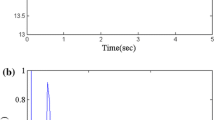Abstract—At present, one of the most effective methods for detecting dangling bars in squirrel-cage rotor windings of induction motors operating under severe starting conditions is the spectral analysis of stator current in a steady-state operation mode. The existing methods of testing in starting modes are not sensitive enough or their study has not been completed, although it is precisely such methods that allow diagnostics of machines that cannot be inspected in the steady-state operation mode. The purpose of this article is to develop a method for monitoring the state of rotor windings in induction motors operating under severe starting conditions based on the stator current in the starting mode, which is an urgent task. The studies were carried out both on digital models of an induction motor, developed in the Ansys software package, and on an experimental stand with a low voltage supplied to a low-voltage motor to increase the duration of its start. Signal processing is performed in the Matlab software package using the short-time Fourier transform. It is shown that only in the presence of a broken rotor bar, the amplitude of the harmonic component of the order coinciding with the number of motor pole pairs sharply increases at the lower side frequency; this indicates the presence of damage. It is shown that the developed technique for monitoring the condition of rotor windings in induction motors operating under severe starting conditions is more sensitive to broken rotor bars than the existing methods; this makes it possible to timely detect damage to rotor windings and prevent sudden failures of induction motors.







Similar content being viewed by others
REFERENCES
Jahić, A., Hederić, Z., and Atić, M., Detection of failures on the high-voltage cage induction motor rotor, Int. J. Electr. Comput. Eng. Syst., 2015, vol. 6, no. 1, pp. 15–21.
Siddiqui, K.M., Sahay, K., and Giri, V.K., Health monitoring and fault diagnosis in induction motor—a review, Int. J. Adv. Res. Electr. Electron. Instrum. Eng., 2014, vol. 3, no. 1, pp. 6549–6565.
Sonje, D.M. and Munje, R.K., Rotor cage fault detection in induction motors by motor current signature analysis, in IJCA Proc. Int. Conf. Comput. Intell. (ICCIA), 2012, vol. 2, pp. 22–26.
Veinreb, K., Diagnostics of the rotor of induction motor by the method of spectral analysis of stator currents, Vestn. Ross. Akad. Nauk. Energ., 2013, no. 4, pp. 133–154.
Thakur, A., Wadhwani, S., and Wadhwani, A.K., Motor current signature analysis as a tool for induction machine fault diagnosis, Int. J. Comput. Sci. Inf. Technol. Res., 2015, vol. 3, no. 3, pp. 309–313.
Savel’ev, V.A., Strakhov, A.S., Novoselov, E.M., Skorobogatov, A.A., and Sulynenkov, I.N., Experimental and analytical determination of the diagnostic sign of defects in the rotor winding of an induction motor, Vestn. IGEU, 2018, no. 4, pp. 44–53.
Devillers, E., Le Besnerais, J., Lubin, T., Hecquet, M., and Lecointe, J., An improved 2D subdomain model of squirrel cage induction machine including winding and slotting harmonics at steady state, IEEE Trans. Magn., 2018, vol. 54, no. 2, p. 12.
Pu Shi, Chen, Z., and Vagapov, Y., Wavelet transform based broken rotor-bar fault detection and diagnosis performance evaluations, Int. J. Comput. Appl., 2013, vol. 69, no.14, pp. 36–43.
Pineda-Sanchez, M. et al., Instantaneous frequency of the left sideband harmonic during the start-up transient: A new method for diagnosis of broken bars, IEEE Trans. Ind. Electron., 2009, vol. 56, no. 11, pp. 4557–4570.
Bryukhanov, G.A. and Knyazev, S.A., Method and device for diagnosing the state of rotor windings of asynchronous electric motors, Electr. Stn., 1986, no. 2, pp. 44–45.
Skorobogatov, A.A., Analysis of the spectrum of magnetic field in the gap of induction motor with damage to rotor winding, Vestn. IGEU, 2006, no. 2, pp. 75–78.
Heller, B. and Hamata, V., Harmonic Field Effects in Induction Machines, Prague, 1977.
Nazarychev, A.N., Skorobagatov, A.A., and Novoselov, E.M., Diagnostics of breaks of rotor winding bars in electric motors based on stator current analysis, Russ. J. Nondestr. Test., 2011, vol. 47, no. 3, pp. 209–215.
Nazarychev, A.N., Novoselov, E.M., Polkoshnikov, D.A., Strakhov, A.S., Skorobogatov, A.A., and Pugachev, A.A., Experimental determination of diagnostic signs of damage to the rotor windings of high-voltage power plant motors in startup mode, Russ. J. Nondestr. Test., vol. 56, no. 5, pp. 408–416.
Author information
Authors and Affiliations
Corresponding authors
Additional information
Translated by V. Potapchouck
Rights and permissions
About this article
Cite this article
Nazarychev, A.N., Novoselov, E.M., Polkoshnikov, D.A. et al. A Method for Monitoring the Condition of Rotor Windings in Induction Motors during Startup Based on Stator Current. Russ J Nondestruct Test 56, 661–667 (2020). https://doi.org/10.1134/S1061830920080070
Received:
Revised:
Accepted:
Published:
Issue Date:
DOI: https://doi.org/10.1134/S1061830920080070




